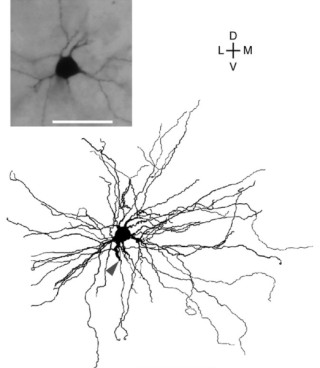Here’s a title which might be up the alley of some conspiracy theorists. Instead of some high-level conspiracies though, I will talk about the brain and a fascinating type of neurons, which are the very definition of an “internal GPS”.
I present you – the grid cell:

These cells have been found in the hippocampus – this little partition of our brains that seems to be responsible for so much! In 2014, the people who first reported the special activity of some neurons when an animal is navigating through a geographical area, were awarded the Nobel Prize in Physiology or Medicine. It does not come as a surprise that there are dedicated to navigation cells in our brain – after all one our most basic abilities is to examine and remember the surroundings, in order to know where we are now, and how to get where we want to get later. Dr. O’Keefe’s team discovered these neurons when observing how some nerves in a particular part of the hippocampus fire signals when a mouse is navigating freely in its environment. The unexpected was that these neurons do not reflect sensory activity – for example if the mouse sees the walls and corridors of the structure it is walking around and adjusts its path, but rather remembers the area and extrapolates its position based on previous knowledge of it, creating a complex map in its brain which it is able to follow.
These place cells are part of a complex navigational hardware in the brain. Another type of cells that works in cooperation with the place cells, acts as a compass and is active only when the head of the animal is turned in a specific direction – much like the needle of a compass reacts to the north pole. Yet another type of neurons fire to indicate specifically where the borders of the area are – the walls of the maze in which the mouse is running. Additionally, some neurons form physical hexagonal cells in the brain, separating the mind-map of the mouse to smaller areas. In the end, the spacial navigation of the brain turns out to be a rather complex integration system, where the compass cells, the border cells and the hexagonal neurons fire directly to the place cells in the hippocampus.
Another interesting discovery to follow from this knowledge is that scientists managed to unveil partially how memories are encoded. Turns out that the same place cells that have been used during the active stage of the mouse, often fire during the resting period that follows, and scientists believe this has to do with consolidation of the knowledge of the mouse’s environment to long-term memory, while the animal is asleep.
As you might suspect, mice are not the only mammals with such a sophisticated navigational system – and of course – we, humans, have it too. If you are like me, you get lost more easily than not, but don’t despair – it does not mean that our place cells don’t work. It probably is the loss of an evolutionary pressure – when in a crowd you can always ask someone for directions, but also the availability of street signs, maps, and GPS it made remembering one’s position in great details increasingly non-vital. A study was conducted on the development of the hippocampus of London taxi-drivers, which go through severe training to remember every single street in London without the help of a map until they can even get their license. Turns out, their hippocampus grows significantly while they are training their spacial memory, and probably their place cells get the work out too to allow for such amazing navigational skills. So if you do get lost easily – ” hop on the wheel” and train those place cells of yours (someone once said that the brain is like a muscle and can be trained), or just “plug-in” and use that GPS to make your life easier.
(Here you can see how a mouse gets its mind-map recoded by scientists from MIT)

